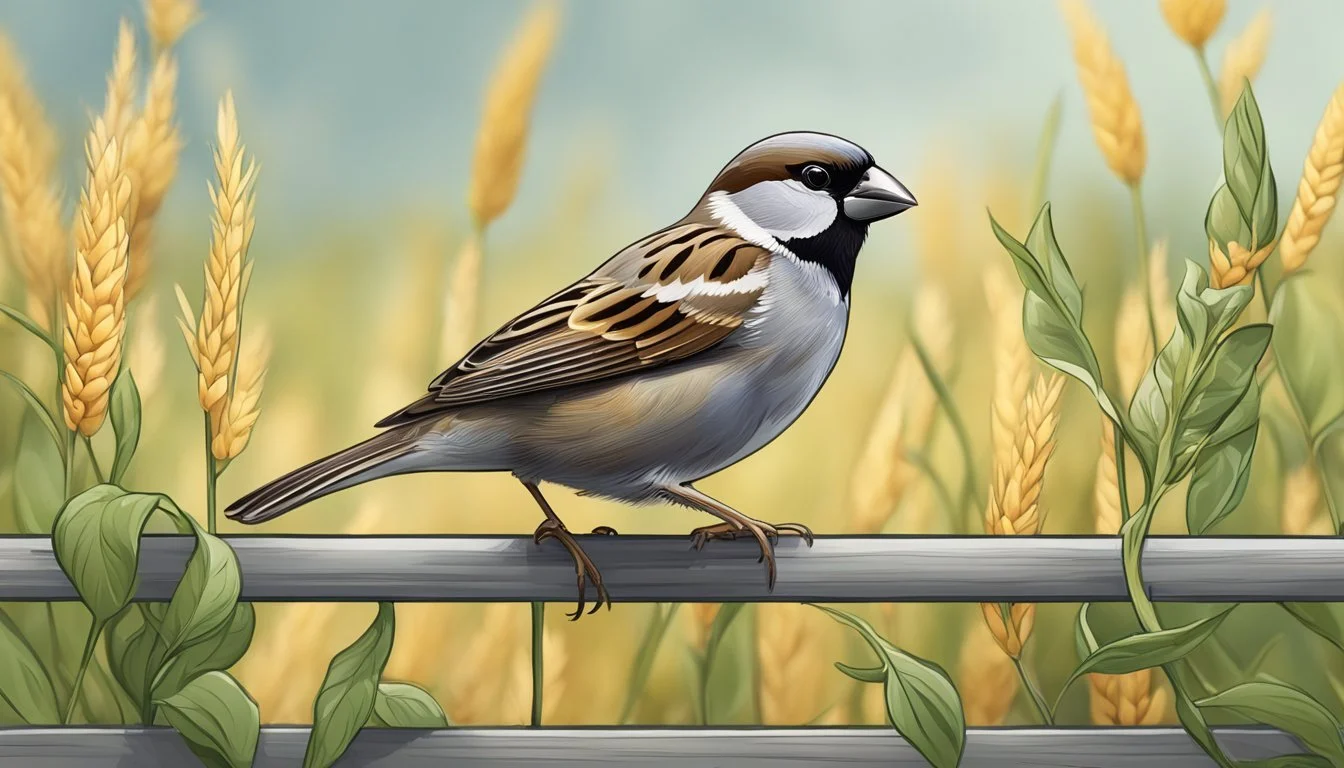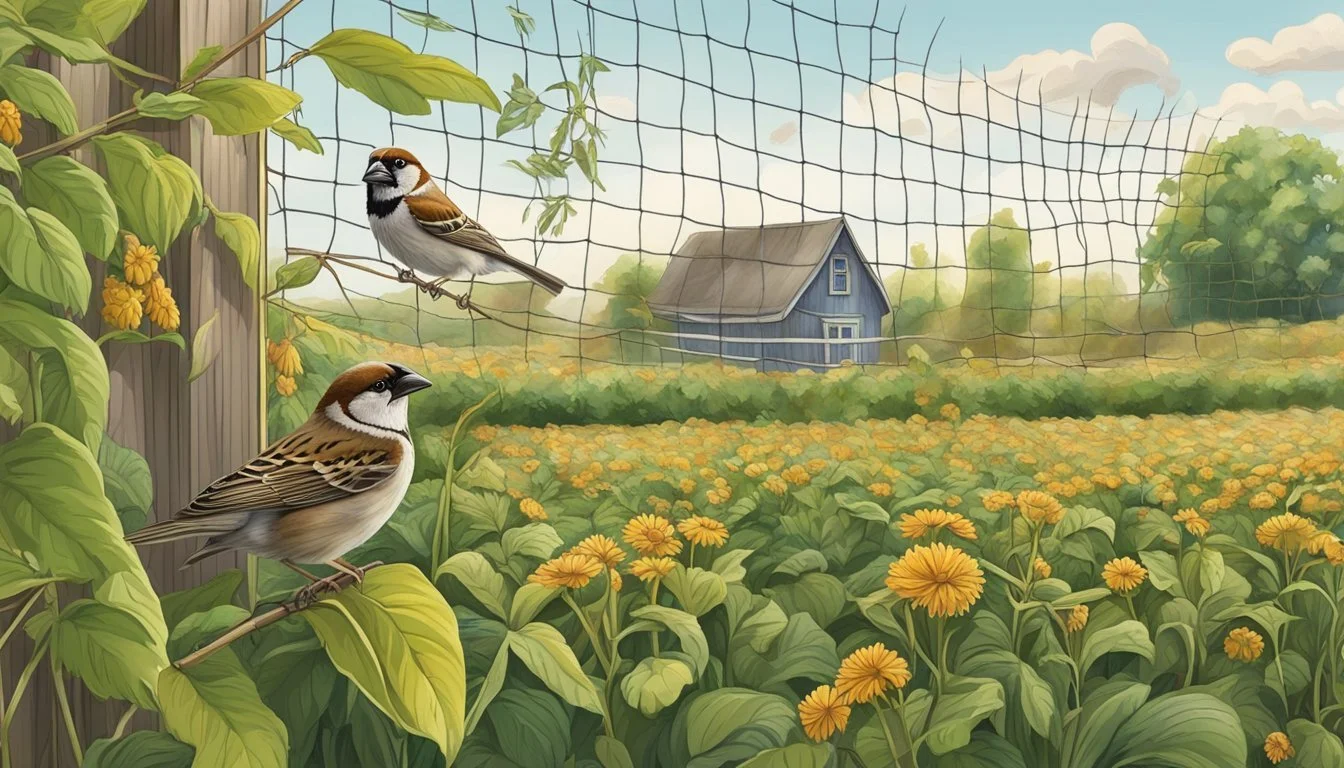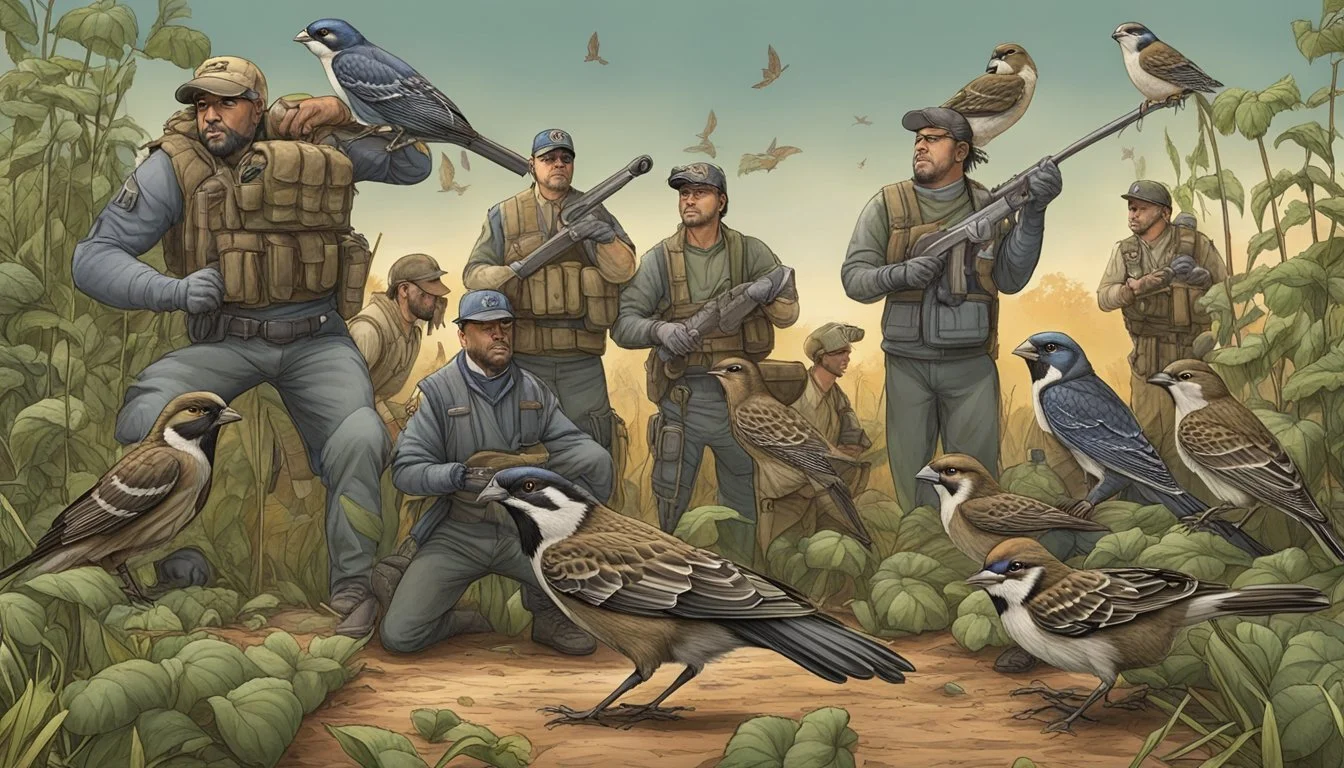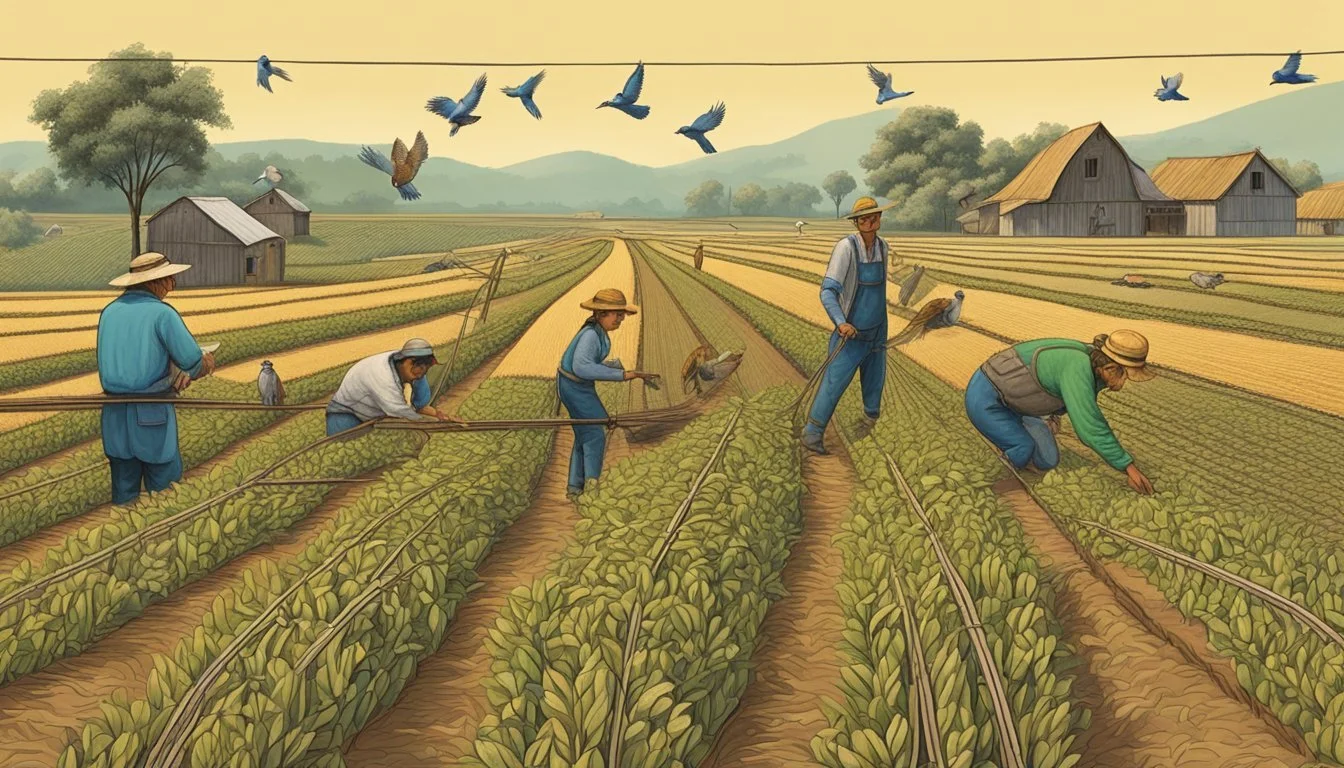Protecting Crops from House Sparrow
Proactive Management Strategies
House sparrows, a common sight in many urban and rural areas, have long been associated with humans and their structures. While these birds are often considered charming by onlookers, their presence can pose significant problems for agriculture. Classified as an invasive species in North America, house sparrows compete with native bird species and can cause considerable damage to crops. To mitigate these issues, farmers and wildlife managers have developed various strategies to protect agricultural lands from the adverse impacts of these adaptable birds.
Management practices aimed at deterring house sparrows from agricultural areas must be both effective and humane, respecting the balance of the ecosystem. The birds' ability to thrive in the presence of human activity makes them a challenging pest to control. They have a robust reproductive rate and are known to displace native species, aggressively competing for nesting sites. As agriculture seeks to coexist with wildlife, innovative solutions are essential to ensure that both crop yield and biodiversity are maintained. Understanding the behavior and ecology of the house sparrow is key to developing integrated pest management techniques that safeguard crops while minimizing harm to the birds and preserving the integrity of native species' habitats.
Recognizing the House Sparrow
Accurate identification of the House Sparrow is fundamental to managing their impact on crops and native bird species. This section will guide you through the physical characteristics, behavioral traits, and their habitat and distribution to help you distinguish them from other sparrows.
Physical Characteristics
The House Sparrow is a robust bird with a stout body, which typically measures around 6 inches in length. They exhibit sexual dimorphism: the males have a distinctive black bib, gray crown, and chestnut nape, while the females and young are duller with brown and gray tones. Their backs are typically covered with black streaks on a brown background.
Behavioral Traits
The House Sparrow is known for its aggressiveness, often outcompeting native birds for resources. These birds are highly adaptable, capable of living in close quarters with humans in urban and farming areas. They display a variety of social behaviors and can be seen taking dust baths, sunbathing, and vigorously defending their nests.
Habitat and Distribution
Originally native to parts of Eurasia and Northern Africa, the House Sparrow has become one of the most widely distributed bird species on the planet. They thrive in urban areas such as cities and towns but are also found in rural environments. In North America, they were introduced in the mid-19th century and have since become a common presence across the continent, often associated with human habitation.
Impact on Agriculture
House sparrows, while small and innocuous-looking, can substantially affect agriculture by damaging crops and seeds. Their behavior, which includes feeding on grains and seeds, has led to conflicts with farmers and conservationists alike.
Threats to Crops
House sparrows are known for their aggressive feeding habits and tendency to consume and spoil various crops. They target a range of agricultural products, specifically those that include seeds and grains. For instance, the House Sparrow's appetite for rice, corn, and cotton seeds makes them a concern for farmers. Their feeding can reduce yields and affect the quality of the harvest.
Affected Crops:
Rice
Corn
Cotton
Additionally, house sparrows often gather in large flocks, increasing the extent of damage to fields. They are not solely eating the crops but also disturbing the sowing of seeds by pecking at newly planted areas, leading to significant revenue losses for farmers.
Competition with Native Birds
The introduction and proliferation of house sparrows have increased competition with native bird species for food and nesting sites. Aggressive by nature, house sparrows often displace the eggs of native songbirds like bluebirds and purple martins from their nests. This displacement has implications for maintaining the diversity and health of the ecosystem, where each bird species, including the native songbirds, plays a crucial role in the dynamics of local wildlife populations.
Displaced Native Species:
Bluebirds
Purple martins
Other songbirds
Beyond the direct competition for nesting sites, the dominance of house sparrows can lead to a decline in the populations of native birds, altering the balance within the ecosystem and possibly affecting other facets of agriculture, such as pest control, which these native birds contribute to.
Legal and Ethical Considerations
When considering actions to protect crops from House Sparrows, one must navigate the complexities of federal law and balance them against ethical wildlife management practices. This section will outline the legal protections—or lack thereof—for House Sparrows and describe the guidelines that inform humane wildlife management.
Protected Status
House Sparrows (Passer domesticus) are not protected under the Migratory Bird Treaty Act as they are a non-native species. They were introduced to North America in the late 19th century and are often regarded as pests due to their sometimes harmful interaction with crops and native species. However, one must verify state and local regulations which may have different protections in place or specific requirements for handling these birds.
Wildlife Management Guidelines
Wildlife management guidelines emphasize the importance of ethical and humane treatment when controlling House Sparrow populations. While these birds are considered pests, the methods used to manage them must be humane and in consideration of broader ecological impacts. For example, avoiding the use of foods that attract sparrows or placing nest boxes away from buildings can be effective, as House Sparrows prefer to nest near human structures whereas many native species do not. These practices should be informed by current scientific research and designed to minimize harm, both to the House Sparrows and the surrounding wildlife.
Non-Lethal Deterrent Strategies
Effective non-lethal deterrent strategies focus on preventing house sparrows from accessing food, water, and nesting sites without harming them. Employing methods such as exclusion, habitat modification, and scare tactics can protect crops and deter sparrows.
Exclusion Methods
Exclusion methods involve creating physical barriers to prevent sparrows from reaching crops or potential nesting sites. Netting can be installed over garden areas to keep house sparrows at bay. Installing mesh or wire over roofspaces and rafters stops them from establishing nesting sites. Birdhouses should be equipped with entrance holes small enough to exclude larger, aggressive species like house sparrows and starlings.
Habitat Modification
Habitat modification reduces the attractiveness of the environment for house sparrows. It's essential to remove access to potential nesting sites like dense shrubs and thickets. Keep trash secured and tidy to limit alternative food sources. Limit the number and perches available for sparrows to congregate around the garden. It's also recommended to replace large birdhouses with designs exclusive for native species.
Frightening Devices
Frightening devices can effectively deter sparrows using scare tactics. Objects that move, reflect light, or make noise can make an area less appealing to them. Mist systems or water squirters unsettle these birds and discourage them from loitering in gardens and crop areas. It's important to change tactics occasionally as sparrows can become accustomed to certain frightening devices over time.
Population Control Measures
Effective population control measures are critical in managing house sparrow populations and mitigating their impact on crops and native birds. These measures focus on reducing their reproductive success and carefully relocating them to suitable areas away from agricultural zones.
Reproductive Interference
One method to manage house sparrow populations is by interfering with their reproductive cycles. Installing specialized nest boxes designed to deter house sparrows can prevent them from breeding. For example, employing monofilament lines on boxes can discourage their nesting. Additionally, regularly inspecting nest boxes for house sparrow nests and removing their eggs or nests when found can significantly reduce their ability to multiply.
Capture and Relocation
Trapping is another effective strategy used to control house sparrow numbers. Various traps can be deployed to capture them humanely. Once captured, they can be relocated to areas where their impact on crops and other nesting birds is minimized. However, it's essential to obtain the necessary permits and follow local regulations concerning the capture and relocation of wildlife. It's also vital to ensure that these measures do not adversely affect the sparrow populations in the relocation site.
Feeding Practices and Alternatives
To protect crops from house sparrows, birders can adopt specific feeding practices and alternatives that deter this invasive species while supporting native songbirds. Strategic seed selection and careful feeder types and placement are crucial.
Seed Selection
Choosing the right seeds is a powerful tactic to discourage house sparrows. Millet, which is often found in mixed birdseed, is a favorite food of house sparrows. Instead, offering seeds like safflower, which these birds find less palatable, can be an effective deterrent. Similarly, Nyjer (thistle) seed and safflower seed are more likely to attract finches and other desired songbirds, reducing competition from house sparrows. Cracked corn and wheat should be avoided or minimized, as these are very attractive to house sparrows.
Examples of Seed Preferences:
Preferred by House Sparrows: Millet, Cracked Corn, Wheat, Bread
Less Attractive to House Sparrows: Safflower Seed, Nyjer, Nuts
Feeder Types and Placement
The design and positioning of feeders are critical in managing house sparrow populations. Tube feeders with short perches do not accommodate house sparrows as comfortably as larger songbirds or orioles. Feeders with weight-sensitive mechanisms that close when a bird heavier than the targeted species lands can also be beneficial. Placement is another key factor; feeders should be placed away from low bushes where sparrows commonly hide. Additionally, rather than offering a large, easily accessible food source, birders should consider using smaller, more specialized feeders that cater to the feeding habits of specific birds and promote diversity.
Bird baths and water sources must also be addressed. Removing traditional bird baths and replacing them with drippers or hanging bird drink stations can provide water to birds without attracting house sparrows. Breaking up large water surfaces with uneven rocks can further discourage their presence.
By implementing these adjustments in feeding practices and modifying feeder and food types, birders can help create an environment that supports a healthy and diverse bird population while reducing the influence of house sparrows on their crops and local ecosystems.
Encouraging Predators and Competitors
To safeguard crops effectively, it is crucial to integrate measures that bolster the presence of pivotal natural adversaries and competitors of the House Sparrow. This strategic approach can lead to a more balanced ecosystem, contributing to the control of this bird species.
Attracting Natural Predators
Natural predators such as hawks and owls can be essential allies in managing House Sparrow populations. They can be encouraged to visit and patrol crop areas by erecting nesting sites like birdhouses designed specifically for these raptors. Tall perches and nesting boxes must be installed away from human activity to offer shelter and a vantage point for these birds of prey.
Hawks: Installing perch poles can make fields more appealing to hawks.
Owls: Owl boxes encourage nesting and assist in establishing a night-time predator presence.
Supporting Competition From Native Bird Species
Introducing native bird species that compete with House Sparrows for resources can be an effective deterrent. Songbirds like bluebirds and purple martins are less aggressive and can share similar food sources, thus reducing the impact of House Sparrows by sheer diversity of native birds.
Bluebirds: These birds are attracted to open woodlands and can be enticed with properly located bluebird boxes.
Purple Martins: Offering gourd houses or multi-compartment birdhouses can entice these communal nesters.
Creating environments conducive to a broad range of native bird species increases the natural competition for nesting sites and resources, making it less appealing for House Sparrows to dominate. Providing a variety of nesting box types and preserving natural habitats contributes to this competitive atmosphere.
Chemical and Physical Remedies
In the management of house sparrow populations, one can approach pest control through chemical repellents and physical deterrents. These methods aim to protect crops from the nuisance and potential disease spread by these invasive birds.
Repellents and Sprays
Chemical repellents can deter house sparrows by making the treated area unattractive or uncomfortable for the birds. While these substances are not designed to harm the sparrows, they can effectively discourage them from perching or nesting in treated zones. Sprays often contain ingredients like methyl anthranilate, a grape-scented substance that is unpleasant to birds. Regular application is pivotal to maintain the area's unsuitability for sparrows, and thus ensuring the longevity of the repellent's efficacy.
Lethal Methods Considerations
When one considers lethal methods for pest control, certain considerations must be taken into account regarding both ethics and legality. Lethal methods can include the use of guns or traps, which are to be employed as a last resort, typically in rural areas where sparrows pose a significant threat to agriculture. Management of house sparrow populations through lethal means should be informed by local wildlife regulations to ensure compliance with the law and to mitigate any unintended harm to native species. Such methods are really a part of an integrated approach to manage the sparrows' impact effectively.
Monitoring and Adapting Strategies
Implementing successful strategies to protect crops from House sparrows requires ongoing monitoring and the ability to adapt management techniques based on effectiveness. It is crucial to assess and alter methods during critical times such as the breeding season when sparrow populations can rapidly increase.
Effectiveness Evaluation
Constant evaluation of the effectiveness of current strategies is essential. This involves monitoring the numbers of House sparrows within the field environment and noting changes in their behavior, particularly during the breeding season. Data should be collected regarding sparrows' access to food sources and any resultant crop protection issues. Methods that prove effective should be noted, while less effective methods may require modification or replacement.
Record sparrow populations weekly
Note any aggressive behaviors towards crops
Assess damage to crops periodically
Adaptive Management Techniques
Adapting management techniques to the ever-changing field conditions often involves an integrated approach, utilizing both exclusion and population control strategies such as capture and trapping. Exclusion methods can involve physical barriers, while capture may be facilitated using nets or traps. If a particular approach does not yield the desired reduction in sparrow populations impacting crops, it's imperative to adapt the strategy, potentially shifting focus or combining techniques for improved efficacy.
Use nets or traps to capture sparrows efficiently
Install physical barriers as part of exclusion tactics
Combine tactics for comprehensive management
Frequently Asked Questions
In the context of agriculture, effectively deterring House Sparrows is crucial for protecting crops. This section addresses common methods and strategies for managing House Sparrow populations in agricultural settings.
What methods can deter House Sparrows from agricultural areas?
Several methods are effective in keeping House Sparrows away from crops, including the use of scare tactics with decoy predators, reflective tape, and netting to physically block access to plants. Farmers also sometimes employ audio deterrents that mimic distress calls to discourage these birds from settling in crop areas.
Are there any effective repellents specifically for House Sparrows?
Chemical repellents are generally not recommended as they can impact non-target species, but tactile repellents that make surfaces uncomfortable for sparrows to perch on have shown to have some effectiveness. For more targeted strategies, it's essential to consult with wildlife control experts.
Which bird feeders are the best to prevent House Sparrow access?
To reduce House Sparrow populations, it's advisable to use bird feeders designed to exclude sparrows, such as those with weighted perches that close under the weight of heavier birds or with short perches that don't accommodate them.
What strategies can be utilized to get rid of House Sparrows without affecting other bird species?
Careful habitat modification, such as pruning dense shrubs where sparrows might nest, can reduce their presence without negatively affecting other birds. Additionally, selecting bird feed that is less attractive to sparrows, like thistle or safflower seeds, can help to preferentially feed native species over sparrows.
Why are House Sparrows considered a problem for crop protection?
House Sparrows are known to be invasive in many regions outside their native range. Their presence in agricultural areas can lead to significant crop damage as they feed on seeds, fruits, and vegetables, and their nesting habits can displace native bird species.
How can farmers manage House Sparrow populations on their land?
Farmers can manage House Sparrow populations by implementing an integrated management approach that combines physical, auditory, and habitat modification strategies. These may include bird netting, using less palatable food sources, and removing potential nesting sites to make the environment less inviting for House Sparrows.









